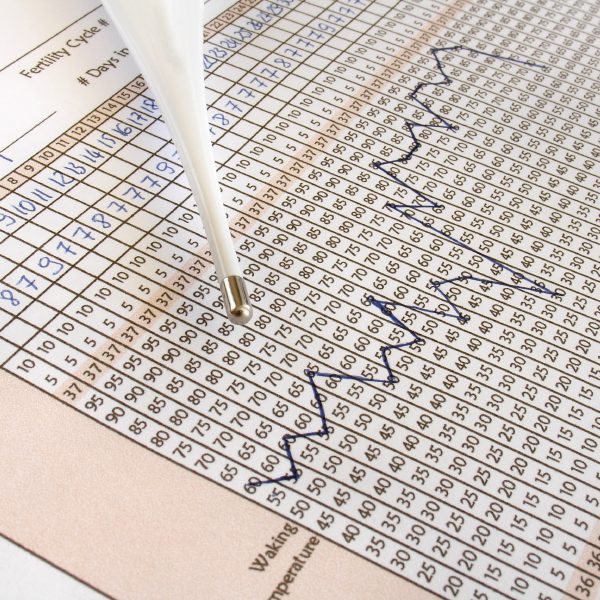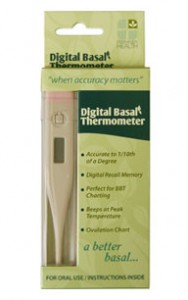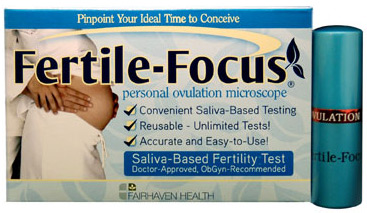by Karen Squires
I’ve just turned 40 years old. That means that I’ve spent over 20 years thinking about my fertility. Sometimes my goal was to achieve pregnancy; other times I wanted to prevent it. Either way, I discovered there are many ways to monitor fertility naturally.
Natural Family Planning
The first day of your period is day one of your new cycle. During the first part of a woman’s monthly cycle, called the follicular or proliferative phase, the egg is maturing under the influence of estrogen. The estrogen continues to rise as the egg matures. When the estrogen reaches a certain level, it triggers the release of LH (Luteinizing Hormone), which causes the ovary to release the mature egg.
The second phase of your cycle now begins, called the luteal or ovulatory phase. After the egg is released from the ovary the follicle that held the egg will collapse in on itself, becoming a corpus luteum. The corpus luteum produces progesterone for the remainder of the cycle.
 Progesterone does three things:
Progesterone does three things:
– It prevents any more eggs from being released that cycle.
– It thickens the uterine lining in preparation for the fertilized egg.
– It causes the cervical mucus to become infertile again along with changing the position and conditions in the cervix.
Progesterone is a heat-producing hormone and causes a slight raise in your basal body temperature. Your temperature chart will show this temperature rise usually about 12-48 hours after ovulation. If no pregnancy occurs the corpus luteum deteriorates about 12-16 days after ovulation and your period begins.
If conception does occur the egg will travel down the fallopian tube to the uterus, a journey that takes 3-4 days. It floats around in the uterus for a few more days and then attaches itself to the uterine lining about 7-10 days after ovulation.
It then immediately releases Human Chorionic Gonadotropin (HCG) into your blood stream and signals the corpus luteum to continue producing progesterone and you will miss your period. It is HCG that home pregnancy tests (HPT) detect in your urine and you may get a positive as early as 9-12 days after ovulation. Wait until your period is late before getting tested.
After you have charted your temperature for about 3-4 cycles, you will be able to determine when ovulation may occur and plan around it. If trying to conceive, you will want to do the “baby dance” during the days immediately before ovulation. If you are trying to avoid pregnancy, you should abstain for about 5 days before ovulation and about 2-3 days after.
In order for the temperature chart to be of use to you, you need to take your temperature at the same time every morning before getting up, so if you have an erratic schedule this may not work for you. You will need a basal body temperature thermometer. It is more sensitive than a regular thermometer and can detect very small changes in body temperature.
One downside to the temperature chart is that it lets you know after ovulation has occurred, not that it is going to. So, if you are trying to conceive, don’t wait until after the temperature rise to have relations as you will actually be practicing birth control. (This is where the saliva testing comes in very handy as it lets you know that ovulation is on its way.)
Most chart examples show 28-day cycles but know that it is not an indication of a fertility problem if your cycles are longer or shorter. What matters is that your luteal phase (the second part of your cycle after ovulation with the temperature rise) is fairly consistent in regards to the number of days from ovulation to menstruation. If you usually have a 13-day luteal phase you should see that same pattern within a day either way, every cycle. (Your luteal phase should be at least 10 days long, some doctors say 12, in order for the egg to implant and signal the ovary to continue production of progesterone. You may have repeated early miscarriages if it is shorter). The first part of your cycle when the egg is maturing, can fluctuate from 3 weeks to 5 weeks without alarm. It is not uncommon for women to ovulate on Day 14, Day 18, Day 21…. irregular cycles are common.
Natural Family Planning also recommends that you include some other methods of checking fertility along with the temperature chart. You can check your cervical mucus as it can give you signs that ovulation is on its way. Leading up to ovulation, cervical mucus becomes fertile and will look much like clear egg white from a raw egg. If placed between a thumb and finger it will stretch quite far, 1-or more inches. After ovulation, this type of mucus goes away and becomes white and pasty, dry, yellow, or any combination of that. Reading cervical mucus signs can take a few cycles to learn. I have only given you a tiny bit of information on how to do it. You’ll need to read about this some more to know what to look for.
Cervical Position
You can also check cervical position. Close to the time of ovulation the cervix becomes softer, moves higher, and opens up. After ovulation, it moves back down and becomes hard and closed. Wash your hands before checking your cervix.
OPK
Another way to monitor fertility, and an expensive one, is ovulation predictor kits (OPKs) They have become the rage for women trying to conceive. A kit usually contains about 5 tests and costs $15 or more. You use one a day around the time you expect ovulation to occur. They look much like pregnancy tests. You dip the stick in your urine and lay it on the counter and wait for the results. You will see a control line show up as the urine moves across the window. You will also see a second line, called the test line, as ovulation approaches. An ovulation predictor test differs from pregnancy tests in that with a pregnancy test even a faint test line is positive and indicates that HCG has been detected and you are likely pregnant. With OPKs, the test line needs to be as dark or darker than the control line to show that ovulation is imminent. I found OPKs to be a waste of money. I have irregular cycles and so I could easily run 10-15 of these per cycle before I got a positive. It was draining my pocketbook using these each month and I found it much easier to keep a temperature chart and monitor other signs that ovulation was approaching. Not using OPKs left some of the fun and spontaneity in doing the baby dance since I wasn’t quite sure when the egg was going to arrive. Of course, using the saliva detector is much cheaper and easier to use so why waste your money.
Check out http://www.fertilityfriend.com. which allows you to record your temperature every day. It also asks you what your cervical position is as well as what your mucus is like (you can choose not to monitor those if it makes you feel uncomfortable) among other questions. It will tell you when you are fertile each cycle, when to test for pregnancy, it will alert you to signs that you may be pregnant, when the baby will be due, along with other valuable information. I have charted on paper (which works very well too) for years and I still learned new things on fertilityfriend. You get 30 days free so try it at the beginning of a new cycle. By the end you’ll have a much better understanding of your fertility. If you decide to continue with on-line charting you are offered a membership at $10 a month, $25 for 90 days or $45 for indefinite use. You can continue to use it free but with less options. It’s fun and you’ll learn a lot. BabyMed.com provides a similar free service.
Saliva Microscope
One method is by using a tiny hand-held microscope used to view saliva to determine your fertile period. These microscopes are about the same size as a tube of lipstick so you can carry them around in your purse. The simplicity in this method of testing is wonderful. No more collecting urine for ovulation predictor kits.
With this tiny microscope, you simply lick the lens and wait 10 minutes for the saliva to dry; then view your results. A woman’s saliva changes in the 3-4 days leading up to ovulation. During those few days electrolytes (or salts) increase dramatically in body fluids (e.g. cervical mucus and saliva) along with the hormone estrogen. This causes a ferning-like pattern to occur in dried cervical mucus and saliva. The ferning is caused by the dried salt and looks much like the frost seen on the window on a winter morning.
 A few days before ovulation you will start to see small lines about the width of a hair and about 1/4 of an inch long. There may be just a few or there may be many of them. The quantity is not as important as the presence of them. You are now approaching ovulation. You should now test at least two times per day. Soon you will see the presence of more lines and they may become longer. The patterns may take different shapes, i.e.: veins in a leaf, snowflakes, spider’s web, frost on a window pane. The lines will connect and overlap, this is the ferning pattern you are looking for. This means you are starting the ovulation process and now is the best time for relations.
A few days before ovulation you will start to see small lines about the width of a hair and about 1/4 of an inch long. There may be just a few or there may be many of them. The quantity is not as important as the presence of them. You are now approaching ovulation. You should now test at least two times per day. Soon you will see the presence of more lines and they may become longer. The patterns may take different shapes, i.e.: veins in a leaf, snowflakes, spider’s web, frost on a window pane. The lines will connect and overlap, this is the ferning pattern you are looking for. This means you are starting the ovulation process and now is the best time for relations.
Continue to test at least two times a day. On any other day in the cycle the dried mucus or saliva will look like random unconnected dots. The fertile type ferning will return to a dot pattern usually about 2-3 days after ovulation. Some women report no ferning the day of ovulation, you will learn what is normal for you after a few cycles. When a combination of dots and ferns are present it is called a “transition” pattern; the woman is less fertile, but conception is still very possible. A little hint; don’t wait until the last day of ferning to do the “baby dance” as you may have missed the egg since ferning may continue for 2-3 days after ovulation. If you wish to conceive, have relations as soon as you see the fertile ferning and continue until it passes back to the infertile dot pattern.
Watch Video: How to Use a Fertility Microscope
Researchers have been studying the changes in cervical mucus during a woman’s cycle since 1945 and fertility clinics and doctors have been using this method of determining fertility for decades. In 1969, Dr. Biel Cassals, a Spanish gynecologist, studied the crystallization of saliva. In 1971, he developed a microscope to check for ferning in saliva. Since then many handheld microscopes have appeared on the market and range in price from about $29.99- $60 on average.
If your child has a microscope, you can use that. 100-200x magnifications is all that is needed. I’ve even used a loupe that’s used for looking at negatives. It is only 8x magnification and I could see ferning. The saliva microscope is more convenient than your child’s microscope though, as they are portable and your child may not appreciate you spitting on their toys. 🙂
Along with checking saliva for ferning you can use other fertility signs to either avoid or achieve pregnancy. The Natural Family Planning method includes using a temperature chart that records your basal body temperature. Your basal body temperature is your body’s temperature at rest. This chart can help you determine if you are ovulating each cycle and about when it happens.
At first, Natural Family Planning may seem like a lot to absorb and you may feel like taking a birth control pill is much easier. It does become easier soon enough though as you practice, and think of the benefits of keeping man-made hormones out of your body. If you want to minimize the amount of time spent looking for signs of fertility, I suggest using the saliva detector and keeping a temperature chart. It’s reassuring to know where you are in your cycle.
There is quite a bit of information on Natural Family Planning whether you are using it for contraception or to achieve a pregnancy. The book I’ve heard most women refer to is Taking Charge of Your Fertility by Toni Weschler. It has color photos of cervical mucus and a blank master basal body temperature chart. Once you’ve read this book, you’ll be well on your way to monitoring your fertility and may become pregnant if that is your goal.
This site http://midlifemom.com/ offers information and support on mid-life pregnancy, empty nest syndrome, menopause, and many other issues related to the aging mom. If you find yourself pushing 40, and either already are or about to become a mom, come right on in, because you’re in good company.







